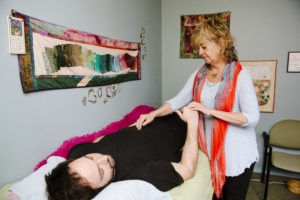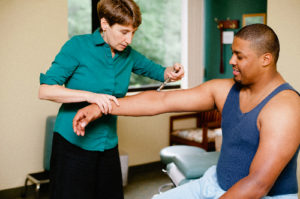Energy Kinesiology
Energy Kinesiology is a non-invasive, holistic approach to health and wellbeing based on a synergistic combination of Western models of neurological muscle function and Eastern models of energy medicine. An important assumption of Energy Kinesiology is that the body naturally moves toward increased health and organization if underlying stress is removed. Energy Kinesiology uses a form of direct biofeedback called muscle monitoring to identify and treat stress or areas of imbalance.
Muscle monitoring can be used to assess the status of almost any neuro-physiological event in the body — whether that event is musculoskeletal, biochemical, or psychological. Muscle monitoring provides a language to communicate directly with the brain-body system. During the past 20 years, more and more sophisticated methods have been developed to increase the specificity of this communication. Muscle monitoring allows the energy kinesiologist to ask ever more detailed questions about where stress is located, and to prioritize how and when to treat it. This technique bypasses the conscious mind and the explicit memory system, going directly to the unconscious mind and deeper implicit memory system.
Energy Kinesiology has its roots in the early 1960’s, when a group of talented American chiropractors, led by Dr. George Goodheart, began discovering an exciting relationship between acupuncture meridians, the internal organs, and skeletal muscles. Within a few short years, they realized that skeletal muscles provide a way to monitor internal function. Dr. Goodheart called this work Applied Kinesiology (AK). AK is an ever increasingly popular chiropractic technique practiced in dozens of countries.
While Energy Kinesiology was initially developed by chiropractors in the US, its incredible versatility and usefulness spawned a rapid rise of treatment applications outside the chiropractic office. Its growth and expansion have been most remarkable in Australia and in Europe, where it is highly respected as a stand-alone profession taught in colleges and universities. Areas of expertise for energy kinesiologists range from health issues to psychological problems, learning disabilities, and developmental delays.
Some of the more notable streams of Energy Kinesiology are: John Thie’s Touch for Health, Richard Utt’s Applied Physiology, Paul and Gail Dennison’s Brain Gym®, Charles Krebs’s L.E.A.P.SM and many, many others.
Energy Kinesiology at the Lydian Center
Joy Del Giudice, CEnK2 has developed Somatic Emotional Acupressure (S.E.A.®), which deals with emotional issues.

